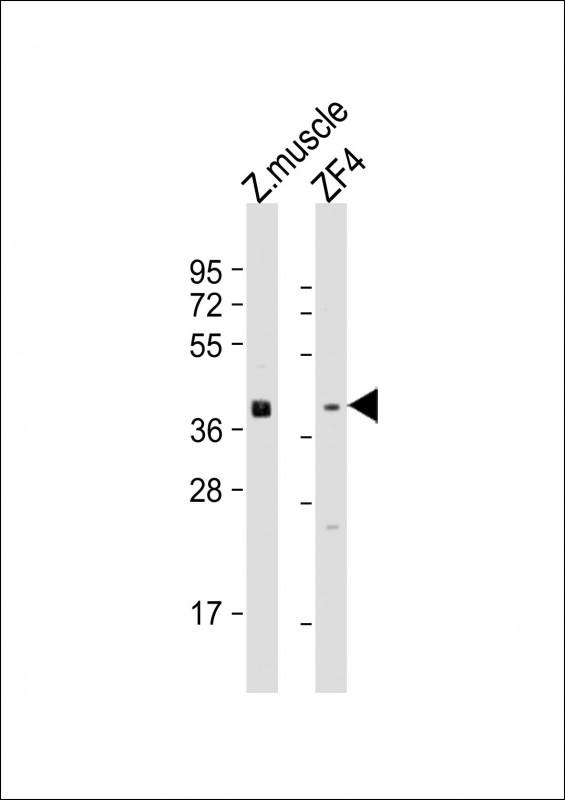Zebrafish wnt8a Antibody (Center)
Purified Rabbit Polyclonal Antibody (Pab)
- SPECIFICATION
- CITATIONS: 1
- PROTOCOLS
- BACKGROUND

Application
| WB, E |
|---|---|
| Primary Accession | P51028 |
| Reactivity | Zebrafish |
| Host | Rabbit |
| Clonality | polyclonal |
| Isotype | Rabbit IgG |
| Calculated MW | 40289 Da |
| Antigen Region | 135-170 aa |
| Gene ID | 30122 |
|---|---|
| Other Names | Protein Wnt-8a, wnt8a, wnt-8, wnt8 |
| Target/Specificity | This Zebrafish wnt8a antibody is generated from a rabbit immunized with a KLH conjugated synthetic peptide between 135-170 amino acids from the Central region of Zebrafish wnt8a. |
| Dilution | WB~~1:1000-1:2000 E~~Use at an assay dependent concentration. |
| Format | Purified polyclonal antibody supplied in PBS with 0.09% (W/V) sodium azide. This antibody is purified through a protein A column, followed by peptide affinity purification. |
| Storage | Maintain refrigerated at 2-8°C for up to 2 weeks. For long term storage store at -20°C in small aliquots to prevent freeze-thaw cycles. |
| Precautions | Zebrafish wnt8a Antibody (Center) is for research use only and not for use in diagnostic or therapeutic procedures. |
| Name | wnt8a |
|---|---|
| Synonyms | wnt-8, wnt8 |
| Function | Ligand for members of the frizzled family of seven transmembrane receptors (Probable). Required for mesoderm and neural ectoderm patterning during gastrulation (PubMed:11703928). Involved in axis formation during embryonic development, via activation of canonical Wnt/CTNNB1 signaling (PubMed:11703928, PubMed:25371059). May be involved in the specification of the spatial patterns of expression of Gsc and other regulatory genes leading to the establishment of the embryonic axis (PubMed:7600994). |
| Cellular Location | Secreted, extracellular space, extracellular matrix {ECO:0000250|UniProtKB:Q9H1J5}. Secreted {ECO:0000250|UniProtKB:Q9H1J5} |
| Tissue Location | Expressed in the margin of the pregastrula embryo destined to be the future mesoderm. |

Provided below are standard protocols that you may find useful for product applications.
Background
Ligand for members of the frizzled family of seven transmembrane receptors. Probable developmental protein. Is likely to signal over only few cell diameters. May be involved in the specification of the spatial patterns of expression of Gsc and other regulatory genes leading to the establishment of the embryonic axis.
References
Kelly G.M.,et al.Development 121:1787-1799(1995).
Lekven A.C.,et al.Dev. Cell 1:103-114(2001).
If you have used an Abcepta product and would like to share how it has performed, please click on the "Submit Review" button and provide the requested information. Our staff will examine and post your review and contact you if needed.
If you have any additional inquiries please email technical services at tech@abcepta.com.














 Foundational characteristics of cancer include proliferation, angiogenesis, migration, evasion of apoptosis, and cellular immortality. Find key markers for these cellular processes and antibodies to detect them.
Foundational characteristics of cancer include proliferation, angiogenesis, migration, evasion of apoptosis, and cellular immortality. Find key markers for these cellular processes and antibodies to detect them. The SUMOplot™ Analysis Program predicts and scores sumoylation sites in your protein. SUMOylation is a post-translational modification involved in various cellular processes, such as nuclear-cytosolic transport, transcriptional regulation, apoptosis, protein stability, response to stress, and progression through the cell cycle.
The SUMOplot™ Analysis Program predicts and scores sumoylation sites in your protein. SUMOylation is a post-translational modification involved in various cellular processes, such as nuclear-cytosolic transport, transcriptional regulation, apoptosis, protein stability, response to stress, and progression through the cell cycle. The Autophagy Receptor Motif Plotter predicts and scores autophagy receptor binding sites in your protein. Identifying proteins connected to this pathway is critical to understanding the role of autophagy in physiological as well as pathological processes such as development, differentiation, neurodegenerative diseases, stress, infection, and cancer.
The Autophagy Receptor Motif Plotter predicts and scores autophagy receptor binding sites in your protein. Identifying proteins connected to this pathway is critical to understanding the role of autophagy in physiological as well as pathological processes such as development, differentiation, neurodegenerative diseases, stress, infection, and cancer.

